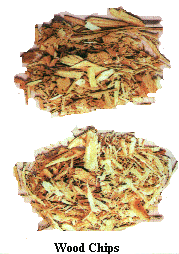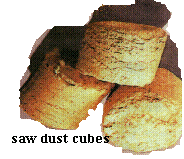- Charcoal
- Wood
- Sawdust
- Peat
- Agricultural residues
Charcoal
Charcoal is a product of wood carbonisation (absense of air). By burning around 4 tonn of firewood, 1 tonn of charcoal is produced. Chracoal offers twice as much as heat produced by wood. Energy lost during the conversion of wood to charcoal can be compensated by using efficient charocal oven or cookstove. Unlike firewood, it burns slowly and does not produce any smoke
Wood
The main combustible components of wood are cellulose and lignine which are compounds of carbon, hydrogen and oxygen. Other minor combustible components in wood are resins and waxes. The major non-combustible component of wood is water which is present upto 50 % in freshly cut wood. Though the ash content is low (less than 1 %), but because of high oxygen content, the calorific value is low (16-20 MJ/kg).
 Next to charcoal, wood is quite suitable fuel for fixed bed gasifiers. As wood contains high volatile matter, updraft gasifier system produce the gas containing tar, which need to be cleaned before using in engines. Cleaning of gas is difficult and labour intensive process. Hence, wood is not suitable in updraft gasifier coupeled with internal combustion engines. However, the gas containing tar from updraft gasifier can be used for direct burning.
Next to charcoal, wood is quite suitable fuel for fixed bed gasifiers. As wood contains high volatile matter, updraft gasifier system produce the gas containing tar, which need to be cleaned before using in engines. Cleaning of gas is difficult and labour intensive process. Hence, wood is not suitable in updraft gasifier coupeled with internal combustion engines. However, the gas containing tar from updraft gasifier can be used for direct burning.Downdraft can be designed to produce relatively tar-free gas. After passing the gas through simpel clean-train, it can be used in the internal combustion engines.
Sawdust
 Unpellatized sawdust lead to the problems of excessive tar production, inadmissable pressure drop and lack of bunker flow. Such problems can be minimized by use of densified (pelletized) sawdust. Small sawdust particles can be used in fluidized gas proucers to produce burning gas. If this gas is used to be in internal combustion engines, fairly good clean-up system is essential.
Unpellatized sawdust lead to the problems of excessive tar production, inadmissable pressure drop and lack of bunker flow. Such problems can be minimized by use of densified (pelletized) sawdust. Small sawdust particles can be used in fluidized gas proucers to produce burning gas. If this gas is used to be in internal combustion engines, fairly good clean-up system is essential. Peat
Peat is the first stage of coal formation. It is not strictly a coal or it can be termed as the most immatured coal. Freshly mined peat contains 90 % moisture and 10 % of solid. It cannot be utilised unless air dried to reduce moisture content to 30 % or less. Its heating value (around 20 MJ/kg) is slightly greater than wood.
As peat contains very high level of moisture and ash, it creates problems in the gasification process. Small downdraft gasifiers fueled with dry peat-pallets have been successfully tested in gas-engine system.
Agricultural residues
If wood is scarce and costly, more abundant or accessible but otherwise less favoured fuels is used instead. Agricultural residues are basically biomass materials that are by product of agriculture. It includes cotton stalks, wheat and rice straw, coconut shells, maize and jowar cobs jute sticks, rice husks etc.
Many developing countries have a wide variety of agricultural residues in ample quanties. Coconut shells and maize cobs have been successfully tested for fixed bed gasifiers and they unlikely creates any problems. Most cereal straws contains ash content above 10% and present slagging problem in downdraft gasifier. Rice husk with ash contents above 20% is difficult to gasify.
To retun to main page click here